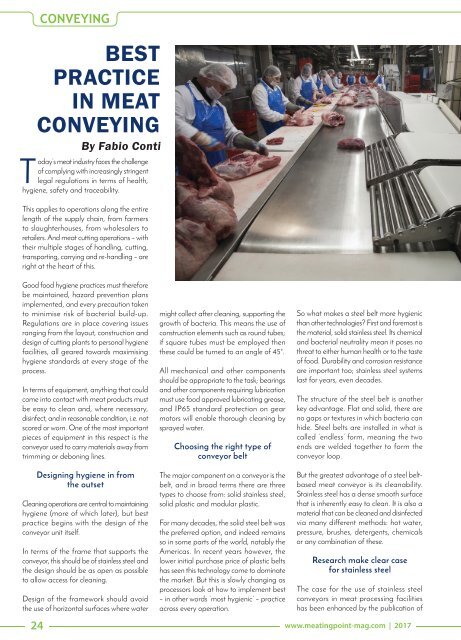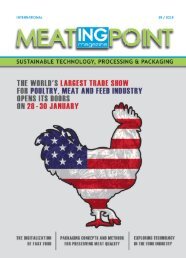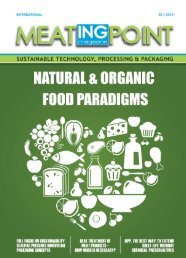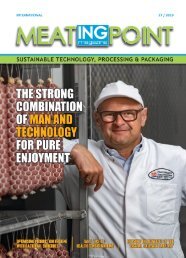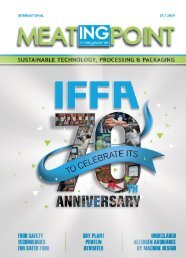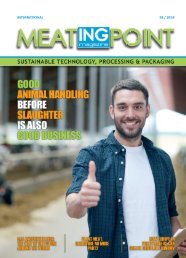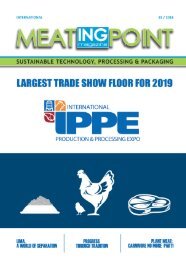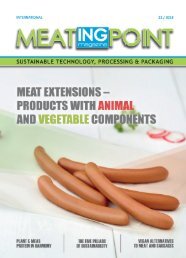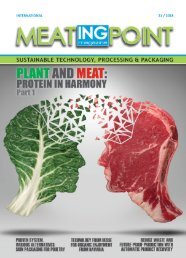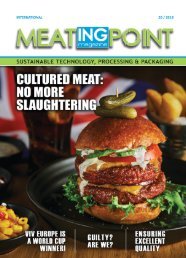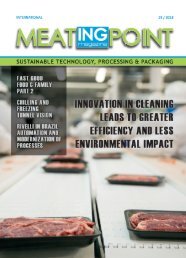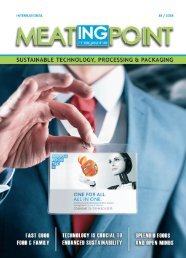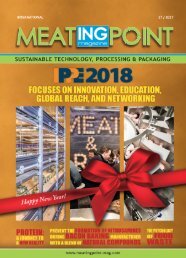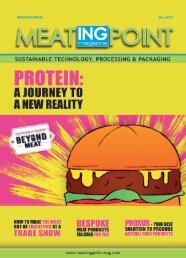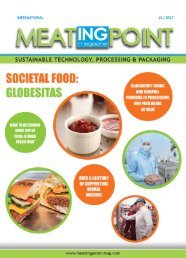MEATing POINT Magazine: #12 / 2017
Create successful ePaper yourself
Turn your PDF publications into a flip-book with our unique Google optimized e-Paper software.
CONVEYING<br />
BEST<br />
PRACTICE<br />
IN MEAT<br />
CONVEYING<br />
By Fabio Conti<br />
Today’s meat industry faces the challenge<br />
of complying with increasingly stringent<br />
legal regulations in terms of health,<br />
hygiene, safety and traceability.<br />
This applies to operations along the entire<br />
length of the supply chain, from farmers<br />
to slaughterhouses, from wholesalers to<br />
retailers. And meat cutting operations – with<br />
their multiple stages of handling, cutting,<br />
transporting, carrying and re-handling – are<br />
right at the heart of this.<br />
Good food hygiene practices must therefore<br />
be maintained, hazard prevention plans<br />
implemented, and every precaution taken<br />
to minimise risk of bacterial build-up.<br />
Regulations are in place covering issues<br />
ranging from the layout, construction and<br />
design of cutting plants to personal hygiene<br />
facilities, all geared towards maximising<br />
hygiene standards at every stage of the<br />
process.<br />
In terms of equipment, anything that could<br />
come into contact with meat products must<br />
be easy to clean and, where necessary,<br />
disinfect, and in reasonable condition, i.e. not<br />
scored or worn. One of the most important<br />
pieces of equipment in this respect is the<br />
conveyor used to carry materials away from<br />
trimming or deboning lines.<br />
Designing hygiene in from<br />
the outset<br />
Cleaning operations are central to maintaining<br />
hygiene (more of which later), but best<br />
practice begins with the design of the<br />
conveyor unit itself.<br />
In terms of the frame that supports the<br />
conveyor, this should be of stainless steel and<br />
the design should be as open as possible<br />
to allow access for cleaning.<br />
Design of the framework should avoid<br />
the use of horizontal surfaces where water<br />
might collect after cleaning, supporting the<br />
growth of bacteria. This means the use of<br />
construction elements such as round tubes;<br />
if square tubes must be employed then<br />
these could be turned to an angle of 45°.<br />
All mechanical and other components<br />
should be appropriate to the task; bearings<br />
and other components requiring lubrication<br />
must use food approved lubricating grease,<br />
and IP65 standard protection on gear<br />
motors will enable thorough cleaning by<br />
sprayed water.<br />
Choosing the right type of<br />
conveyor belt<br />
The major component on a conveyor is the<br />
belt, and in broad terms there are three<br />
types to choose from: solid stainless steel,<br />
solid plastic and modular plastic.<br />
For many decades, the solid steel belt was<br />
the preferred option, and indeed remains<br />
so in some parts of the world, notably the<br />
Americas. In recent years however, the<br />
lower initial purchase price of plastic belts<br />
has seen this technology come to dominate<br />
the market. But this is slowly changing as<br />
processors look at how to implement best<br />
– in other words ‘most hygienic’ – practice<br />
across every operation.<br />
So what makes a steel belt more hygienic<br />
than other technologies? First and foremost is<br />
the material, solid stainless steel. Its chemical<br />
and bacterial neutrality mean it poses no<br />
threat to either human health or to the taste<br />
of food. Durability and corrosion resistance<br />
are important too; stainless steel systems<br />
last for years, even decades.<br />
The structure of the steel belt is another<br />
key advantage. Flat and solid, there are<br />
no gaps or textures in which bacteria can<br />
hide. Steel belts are installed in what is<br />
called ‘endless’ form, meaning the two<br />
ends are welded together to form the<br />
conveyor loop.<br />
But the greatest advantage of a steel beltbased<br />
meat conveyor is its cleanability.<br />
Stainless steel has a dense smooth surface<br />
that is inherently easy to clean. It is also a<br />
material that can be cleaned and disinfected<br />
via many different methods: hot water,<br />
pressure, brushes, detergents, chemicals<br />
or any combination of these.<br />
Research make clear case<br />
for stainless steel<br />
The case for the use of stainless steel<br />
conveyors in meat processing facilities<br />
has been enhanced by the publication of<br />
24 www.meatingpoint-mag.com | <strong>2017</strong>


